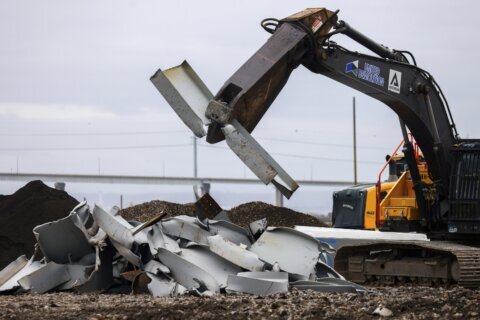HONOLULU (AP) — Amid a continuing crisis over fuel contaminating the Navy’s tap water at Pearl Harbor, Honolulu’s water utility said Friday it shut off one of its wells so it doesn’t taint its own supply with petroleum from an underground aquifer it shares with the military.
The Honolulu Board of Water Supply said it acted shortly after the Navy on Thursday disclosed that a water sample from one of its wells had shown the presence of petroleum. The well is near a giant World War II-era underground fuel tank complex that has been the source of multiple fuel leaks over the years.
The tap water problems have afflicted one of the military’s most important bases, home to submarines, ships and the commander of U.S. forces in the Indo-Pacific region. They also threaten to jeopardize one of Honolulu’s most important aquifers and water sources.
Nearly 1,000 military households have complained about their tap water smelling like fuel, or of physical ailments like stomach cramps and vomiting. The Navy water system serves 93,000 people.
The Navy said Thursday it would flush clean water through its distribution system to clear residual petroleum products from the water. The process, followed by testing to make sure the water meets Environmental Protection Agency drinking standards, could take four to 10 days.
The Navy said it will investigate how contaminants got into the well and fix it.
In the meantime, military officials say they will help affected families move into hotels or new homes.
Ernie Lau, the Board of Water Supply’s chief engineer, said he’s worried the utility could pull contaminated water through the porous lava rock that forms the aquifer, and deliver it to its customers. Because the Navy shut down its well, there’s a chance water would travel to the utility’s Halawa well from the area of the Navy’s well more quickly if the utility continued to pump.
The utility’s Halawa well produces 10 million gallons (37.8 million liters) a day under normal conditions, supplying 20% of the water serving urban Honolulu. The utility will draw on other wells in the meantime and will only run its Halawa well to test the water for contamination, Lau said.
To protect Oahu’s water, Lau urged the Navy to remove the risk posed by the Red Hill Fuel Storage Facility. It consists of 20 aging tanks, each as tall as a 25-story building, that were built in the early 1940s.
“We cannot wait any longer,” Lau said as he choked up during a news conference. “The water resource is precious. It’s irreplaceable. There is no substitute for pure water, and our lives depend upon it.”
He noted Honolulu relies on groundwater for all of its water needs.
At Cheri Burness’ home, her dog was the first to signal something was wrong when it stopped drinking the family’s tap water two weeks ago. Burness started feeling stomach cramps and her 12-year-old daughter became nauseous not long after.
“It was just getting worse every day,” said Burness, whose husband is in the Navy.
The Navy has since started distributing bottled water and said Marines would set up showers and laundry facilities connected to clean water. It is also setting up dedicated medical clinics.
Environmental and Native Hawaiian groups, meanwhile, are demanding a meeting with Navy Secretary Carlos Del Toro. He’s scheduled to visit Hawaii next week to attend a ceremony marking the 80th anniversary of the Japanese bombing of Pearl Harbor.
Burness has been frustrated with the Navy’s response, which she believes has been dismissive of families’ concerns. She pointed to a Monday email from the commander of Joint Base Pearl Harbor-Hickam that told residents the Navy was testing water samples but it had no immediate indication the water wasn’t safe. His email said he and his staff were drinking the water.
“All they had to do was say, ‘We see that there’s a problem, we don’t know what it is, and we’re going to do whatever it takes to find out and fix it.’ That’s all they had to do. And instead, we got: ‘Nope. Looks good. Smells fine. Bye,’” Burness said.
Navy Region Hawaii, which oversees all Navy installations in the state, said the commander’s email was sent when “numbers of concerns were still very low.”
“Since then, the Navy has aggressively increased sampling, testing, communication to families and others impacted, as well as started response teams of experts to address the issues we all are facing,” the command said in a statement.
The most recent leak from the Red Hill Fuel Storage Facility occurred last month. The Navy said on Nov. 22 that a water and fuel mixture had leaked into a fire suppression system drain line in a tunnel. The Navy said it removed about 14,000 gallons (53,000 liters) of the mixture, and said the liquid hadn’t leaked into the environment.
The fuel tanks sit 100 feet (30 meters) above the aquifer. Last month, the Sierra Club of Hawaii and other environmental groups called on the government to shut the tanks down.
U.S. Sen. Mazie Hirono of Hawaii indicated decommissioning the tanks was a possibility, telling a conference call with reporters that “all options are on the table.” But she said first she wanted to focus on making sure people were getting safe water for drinking and other daily needs.
“When people are smelling fuel in their water, this is totally abnormal, totally unacceptable,” said Hirono, a Democrat who chairs the Senate Armed Services Committee’s subcommittee on seapower.
Hirono said she’s asked the Navy to give her a classified briefing on their fuel needs.
Copyright © 2024 The Associated Press. All rights reserved. This material may not be published, broadcast, written or redistributed.






